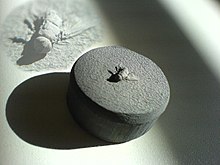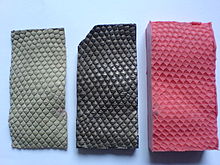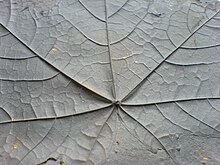Cold pouring
The cold casting is a molding method for producing metal components in a non-temperature-resistant silicone mold. In contrast to other processes, the metallic material does not have to be melted during shaping.
Areas of application
With cold casting it is possible to depict even filigree structures according to any template. The use of silicone is advisable, as its image accuracy is high and the production of the mold is uncomplicated.
The process is mainly used to reproduce detailed natural surfaces such as wood, leather or leaf structures - here the reproduction of lotus leaves is particularly sought because of their self-cleaning surface - for injection molding tools , embossing tools (see also embossing ) or vulcanization tools . The surfaces of the finished metal parts are very resistant to wear thanks to an integrated tungsten carbide layer .
Procedure
All that is needed to create the shape is a template, which can also be of biological origin. A composite of metal powder and epoxy resin is placed in the mold . The resin hardens and gives the body its "green strength". After the resin has hardened, the sensitive green compact can be removed from the mold.
This is followed by a sintering and infiltration process in an oven at up to 1100 ° C. The metal dusts initially held together by the resin sinter together permanently with a maximum shrinkage of one percent . A disturbing change in geometry ( distortion ) occasionally occurs. The dimensions of the finished component are influenced by the shrinkage. This can be counteracted constructively, especially with technical components, by increasing the dimensions of the data record. The shrinkage values are reproducible, but difficult to predict. Depending on the area of application, multiple process runs are necessary to achieve the desired dimensional accuracy. Since the materials used are cost-intensive and a cycle can take up to a week, profitability suffers here.
The last cavities, mainly inside, are closed by infiltration with copper-bronze. In this way you get a metallic copy of a template that can be chosen at will. Without the infiltration process, the part remains porous and air-permeable, so it can be used directly as a mold when deep-drawing plastic cups or blisters . However, attention should be paid to the increased susceptibility to corrosion.



